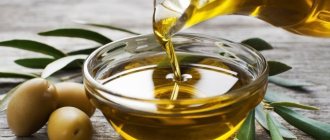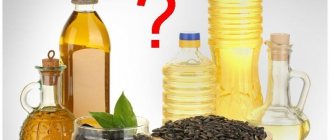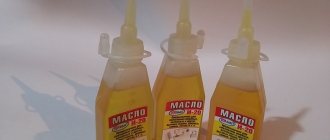Butter is used for cooking, used in sandwiches and used in baking. Any product is stored for a certain period of time and oil is no exception; if the conditions are not met, it will quickly deteriorate and lose its taste. In our article we will tell you how to properly store the product, determine the shelf life of butter according to GOST, and talk about the conditions.
Product preservation conditions
Shelf life is specified in GOST 32261-2013 , and they depend primarily on temperature, type of packaging and type of product.
Butter comes in sweet cream and sour cream varieties, each type is divided into salted and unsalted subtypes. We will not delve into the intricacies of production, we will only note that the basis for the production of the sweet variety is pure cream, and the main condition for sour cream products is the presence of lactic acid bacteria.
The following conditions affect safety:
- The temperature should vary from -180C to +50C.
- Required humidity: 70-90%.
- The packaging must be sealed.
- The amount of light is minimal.
Based on the temperature information provided, it becomes clear that storing butter in the refrigerator is the best option. If we consider options without a refrigerator, then this can be done on the balcony or on the street, but only in the cold season.
Basements and cellars are not entirely suitable places; oil can be stored here, but not for long, including due to high humidity.
Storage without refrigeration
It is possible to store the product without refrigeration for a long time. To do this, you need to prepare it correctly.
The first method will require enamel or glass containers, parchment, and salt.
- The product is divided into parts and wrapped in parchment paper.
- The briquettes are placed in a pan, into which a brine solution is then poured (25 g of salt per 1 liter of drinking water).
- Portions of oil are pressed down, for example, using a massive plate, so that they do not float to the surface.
- Cover the pan with a lid and put it in a cool, dark place.
You can also place the oil, divided into parts, into a clean cloth previously soaked in table vinegar. Place in a cool, dark place. It is important that there is no exposure to sunlight.
Learn how to properly melt butter for storage and how to store it later.
The methods will preserve the freshness and taste of the product for several weeks at a relative humidity of no more than 90%. Without special preparation, butter can be stored at room temperature without exposure to ultraviolet rays for one week.
Sunlight accelerates the deterioration of the product: the nutritional value decreases, yellowing occurs, the oil turns sour
If suddenly the product is exposed to direct sunlight and turns yellow, the situation can be saved. You need to do the following:
- Remove the top yellowed layer.
- Place the rest on a heated frying pan. Wait until the butter is completely melted.
- Remove the top substance and dispose of the sediment.
Do you know that…
Butter contains about 20 essential fatty acids, vitamins A, D, E, K. Under the influence of high temperatures and UV rays, substances oxidize and their beneficial qualities disappear.
How can you tell if the oil has gone bad?
It is worth focusing on the shelf life of butter if the storage conditions are observed. There are no guarantees that they were not violated during transportation, in a warehouse, on store shelves, or in a market.
How to identify a spoiled product:
- Inspect the packaging . Set aside packages with damaged foil and parchment. In places where there were ruptures, the piece was in contact with air. Microbes are concentrated there and spoilage processes are started.
- Inspect the piece . Uneven pigmentation, dark plaque, gray spots, changes in structure and consistency are a bad sign.
- Smell . Spoiled butter has a sour, musty odor. You can smell mold in the distance. Try it. A sour taste with hints of bitterness signals spoilage and expiration.
If, despite the normal taste, the oil still raises doubts, there is no need to use it fresh for sandwiches or cream. Like cottage cheese or milk, cheese, you can use it to make baked goods, casseroles, and other heat-treated foods.
Signs of unfitness for food
It is quite simple to understand that a product has gone bad, since when it is unfit for food there are obvious signs:
- unpleasant odor, with some putrid notes;
- the taste is bitter, yet cloying;
- the color changes from light yellowish to rich, dark yellow.
This phenomenon is called staffing and is the result of dehydration of the top layer of the briquette. As a result, oxidative processes within the product are activated. A similar condition of oil can be observed not only after its expiration date, but also in case of non-compliance with storage standards - temperature conditions and humidity indicators.
Shelf life of butter
Butter belongs to the category of perishable products, so its shelf life is short.
First of all, the shelf life depends on the packaging and compliance with the temperature regime.
Packaged butter has a shelf life of 10 days if its wrapper is made of parchment, 20 days if the wrapper is made of foil.
The shelf life of homemade oil, made independently, has the same terms as that of the factory one, and depends on the packaging and storage conditions.
Butter with any fillers has a shelf life of 15 days. Ghee, which is fat rendered from butter, has the longest shelf life - up to 1 year.
Storage conditions and temperature
Creamy fat products are classified as perishable; storage requires compliance with certain conditions.
Primary requirements:
- temperature range from -18 to +5 °C;
- humidity from 70 to 90%;
- sealed packaging;
- lack of light.
Suitable storage locations:
- fridge;
- freezer;
- balcony, street in winter.
Unsuitable places:
- kitchen table, cabinet;
- street, balcony, veranda in the warm season;
- basement, cellar, damp rooms.
The shelf life of butter at a temperature of 0 +5°C is up to 2-5 weeks. Freshness is affected by weight and container. In the freezer for 75 days at a temperature of -3 to -14 °C. The maximum shelf life at -14 °C is 4 months. Recommended packaging: sealed containers, foil, vacuum bags.
Where do you prefer to store your butter?
In the refrigeratorIn the freezer
How long does butter last before and after opening the package?
For almost all types of oil, temperature is of great importance for shelf life.
In a refrigerator
For butter, it doesn’t really matter whether the packaging is opened or not, the main thing is the material from which it is made. If the packaging is paper (parchment), then this oil is stored in the refrigerator for about 10 days.
In order to extend its shelf life, you can transfer the oil to an oil dish with an opaque lid. Then the shelf life will increase to 15 days.
Oil packed in foil can be stored in its original packaging even after opening.
In the freezer
Can it be frozen? In the freezer at temperatures down to -15 ° C, oxidative processes in fat and oil products slow down sharply, but do not stop.
You can extend the shelf life of butter by putting it in the freezer. In this case, the oil can be stored for up to 1 year.
At room temperature
At room temperature, butter can be stored for a short time in the absence of heat sources or direct sunlight. Usually after 48 hours the oil begins to deteriorate.
Placing the oil under pressure helps to extend its shelf life at room temperature. Fill the oil with salted water, close the lid and place a weight on top. Using this old-fashioned method, the shelf life can be extended to 1 week.
Dependence on fat content
Let's consider shelf life depending on fat content, analyze regular butter of different fat content, as well as ghee and butter paste. We analyze products that are stored in unsealed polymer containers at temperatures from -30C to -60C. The data is presented in the table:
| Type, fat content | Timing, days |
| Oil paste with fat content up to 40% | 30 |
| Oil 40–49% | 50 |
| 50―59% | 50 |
| 60―69% | 60 |
| 72,5―79% | 60 |
| 80―85% | 60 |
| Ghee | 60 |
The table shows that the higher the fat content, the longer the sales and storage time.
Container and packaging
An oil dish is a bowl with a screw-on lid for storing the product of the same name. Only he will not lie in it for more than 10 days. The oil is often removed, oxygen, microbes from a knife, spoon, or some crumbs get into it. All this accelerates spoilage, increases acidity, and produces an unpleasant odor. We recommend putting a small amount in the oiler for use in the coming days. Store the rest of the mixture in another container.
Dishes and packaging options:
- parchment _ Used by manufacturers for factory packaging. Can be used at home. A parchment sheet allows odors to pass through. Oil cannot be stored for more than 3 weeks at above-zero temperatures and 60 days frozen;
- foil _ Better than parchment. Modern oil and fat factories have switched to foil wrapping. Extends shelf life twice as much as parchment;
- sealed polymer boxes, containers . Ideal container for freezing. At temperatures below -10°, the oil will not lose its properties and taste for four months;
- plastic containers with lids . Used for freezing and storing in the refrigerator. It is important to select the size to reduce the air gap.
Plastic bags are not the best packaging for storing butter at above-zero temperatures. But suitable for freezing. It is advisable to use food-grade polyethylene film. The best choice is vacuum bags. They increase shelf life.
How to recognize a natural product
Real butter should contain nothing except animal fat and water, the latter no more than 16%. But today counterfeits containing vegetable oils often appear on store shelves, the most unpleasant and even dangerous of which is palm oil.
And not all manufacturers honestly write on the packaging that this is a spread - a mixture of butter and vegetable oils. Many even claim that it was made according to GOST. But when we bring it home, we wonder why the butter doesn’t freeze in the refrigerator? Yes, precisely because it contains a lot of vegetable fats.
How to distinguish a fake?
There are several signs that this can be done in the store.
- Take the pack from the refrigerator in your hands and press the packaging with your finger. It should not give in, remaining firm. If you feel a pliable plastic consistency, then it is a counterfeit product.
- Now peel back the packaging, if possible, and inspect the inside of it: there should be no traces of oil on it.
- You can also check the quality of a natural product, but to do this you need to wait until it warms up a little. When you press the surface with your finger, it should not be serum, but clear droplets of water. If there is whey, it means the product is poorly washed and will quickly deteriorate.
- The price of real butter cannot be very low. This is also one of the quality indicators.
But at home we can carry out more thorough and revealing research, since here no one limits us and there are more opportunities for this.
- Heat a piece of butter in the microwave until it boils. The spread will turn into a homogeneous yellowish liquid, and the natural product should contain small lumps.
- Place the pack in the freezer for several hours, then remove and cut with a knife. Should butter freeze in the refrigerator - yes, of course. Therefore, when you try to cut it, it will crumble. If the product gives in easily, leaving marks on the knife, it definitely contains vegetable fats.
- Melt the butter in a frying pan on the stove. When heated, a real creamy product begins to emit a pleasant milky smell, and when boiling it foams.
These simple methods will help you avoid making mistakes in the store next time.
Summarize
- Butter is a versatile dairy product that can be safely frozen without compromising its quality or taste.
- 200g packs of butter can be frozen at -18°C and stored for up to 12 months, and bulk blocks can be stored for up to 18 months without loss of quality.
- Avoid freezing butter in wax paper and use the original packaging, parchment paper, foil, plastic bags, or cling film instead.
The article was prepared by experts for informational purposes only. It should not be used as a guide for treating medical conditions and is not a substitute for professional medical advice, diagnosis, or treatment. In case of illness or any symptoms, you should always consult a doctor and not self-medicate.
Tags: Butter
About the author: Anastasia Sheveleva
Candidate of Medical Sciences, doctor of the highest category, therapist, registered dietitian, nutrition consultant. More about the author.
- Related Posts
- What time of day is best to eat carbohydrates?
- Top 12 Foods Containing Lean Protein
- An apple before bed: is it possible or not?
« Previous entry
Contains a lot of fat
Butter is a dairy product - meaning that it is made from the milk of mammals (usually cows).
It is made by whisking milk or cream until it separates into buttermilk, which is mostly liquid, and butterfat, which is mostly solid.
Butter is unique among dairy products because of its very high fat content. While whole milk contains just over 3% fat and heavy cream contains almost 40% fat, butter contains more than 80% fat. The remaining 20% is mostly water (1, 2, 3, 4).
Unlike other dairy products, it does not contain many carbohydrates or protein (3, 5).
This high fat content is what makes butter so thick and spreadable. However, when it is stored in the refrigerator, it becomes hard and difficult to spread.
This leads some people to store butter at room temperature, which ensures it has the perfect consistency for cooking and spreading.
Summary:
Butter has a high fat content - over 80% - which makes it thick and spreadable. The remaining 20% is mostly water.
Quality oil - criteria for selection
- Fat content is no less than 72.5% and no more than 82.5%. The maximum fat content is 99% for ghee;
- Compliance with GOSTs: 52253–2004 and 32261–2013;
- Taste – creamy, delicate, without impurities;
- Color – uniform, light yellow;
- When cooked, it melts easily without forming clots;
- Solid consistency - should not crumble when cutting;
- Quite a high cost. It takes an average of 20 liters of milk to produce one kilogram!;
- When you press the bar, droplets of water are released.
Characteristics of a product of poor quality
When choosing bulk butter, you should initially pay attention to its external characteristics. A low-quality product, the shelf life and manufacturing technology of which were grossly violated, has the following characteristics:
- The color of the product outside is significantly different from the inside;
- The oil cut is characterized by the presence of cracks and defects;
- Wet tray for goods.
Creamy products sold in packages are more difficult to research. However, it is strictly not recommended to purchase oil with damaged packaging. Also, it is not advisable to buy a pack of a perfectly rectangular shape - such a look can only be obtained from a product that contains special preservatives that ensure that it maintains its shape.
Butter is included in the category of perishable food products, which is why, if you discover that you have purchased a product of poor quality, immediately return to the store, because after just a day, even if you have a sales receipt in hand, it will be quite difficult to prove that the product was still spoiled in the first place.
Fresh butter contains 82-84% fat and no more than 16% water, has a uniform yellowish color, and when pressed with a finger, releases droplets of water and does not crumble. If the oil releases whey, it means that it was not washed well after shaking and will quickly deteriorate.
Butter is stored in the refrigerator - this is common knowledge. The storage temperature should not exceed +6 degrees.
Signs of spoiled oil
Prolonged storage of a product under incorrect conditions leads to changes in its taste, color and benefits.
Positive temperatures and light weaken the aroma and cause a stale taste. The oil quickly deteriorates, becomes coated, and acquires a bitter odor. The oxidation of fats produces aldehydes, ketones and other harmful compounds.
How to check product freshness:
- look at the expiration date and date of manufacture;
- cut off a piece to look at the color inside: fresh oil is whitish or light yellow, the cut area is shiny and dry;
- pay attention to the smell.
The main signs of a spoiled product:
- bright yellow color;
- unpleasant odor;
- bitter taste.
The appearance of a yellow coating indicates the rapid spread of bacteria. This oil is disposed of or melted down and used in baking. Sometimes a deep yellow color indicates a large amount of food coloring.
Attention! When purchasing a dairy product on the market from dubious private producers, there is a risk of contracting an infectious disease - salmonellosis. In small industries, the quality of raw materials is poorly controlled. Salmonella in the milk of infected cows is not destroyed for 6 months.
Mold occurs when the integrity of the packaging is compromised. Removing the damaged area will not save the rest of the oil: fungi penetrate deeply and damage the entire product. This product is not used for food.
Methods for resuscitating a spoiled product
What to do if the oil has deteriorated - gone rancid? In general, it is not recommended to use a spoiled product, but if you still need to, here are a few ways to bring it back to life:
- place the butter in the milk, knead it, and then rinse under running water;
- melt, and during the melting process add a crust of white bread. You can add a chopped apple, then strain the oil and repeat the process;
- just rinse the product in running water, then add salt and add some freshly squeezed carrot juice;
- treat with a soda solution (1 teaspoon per glass of liquid), then rinse and salt.











